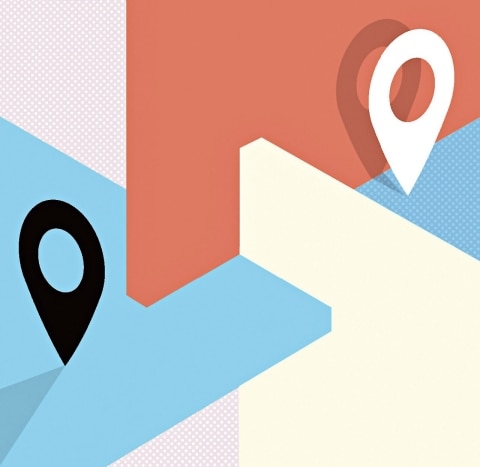The 5 Rules to Follow for a Successful Post-COVID Office

The post-COVID workplace has had its growing pains, whether you work in the office, from home or embrace hybrid. How do we get past half-in, half-out meetings and empty offices to make this new way of working work for everyone? Jane Nicholls details the rules of engagement.
1. Create a healthy culture for remote meetings
“The key to having better virtual meetings is having fewer meetings,” says Darren Murph, head of remote for United States-headquartered GitLab, a software engineering company that was “born remote” in 2011 and today has more than 1900 employees in 60-plus countries. Although Murph thinks meetings will fade into obscurity as their relevance diminishes, he has three suggestions for making meetings better.
If one person is remote, everyone is remote.
“If you do have people in the office, each person needs to go to their desk or if they’re in a shared room, they have their own device and log on to Microsoft Teams or Zoom individually. When everyone is in a box, it enables some sort of equality. For people who are remote, it’s easy to feel like you’re on the B team if you see everyone else together in a meeting room.”
Never have a meeting without an agreed documentation regime.
“At GitLab, every work meeting has a shared document. We use Google Docs; some teams use Microsoft Office. It’s about the rigour of always having an agenda, to make sure there are no pointless meetings – and none without a documented takeaway. If people can’t attend the meeting, they can catch up later because someone put in the effort to document it. That’s a more inclusive way of having a meeting – you don’t have to get up at three in the morning or cancel picking up your child to be there.”
Be specific about what you will and what you won’t have meetings for.
“It’s shocking how many organisations, for example, nitpick about a minor claim on an expense report but let anyone in the company book an hour of synchronous time with 50 people, with no agenda and no guaranteed outcome. That’s incredibly expensive! When you clarify which purposes you’ll have meetings for – and which you won’t – it creates a lot of great conversations across the company and you begin to challenge the old ways of doing things. There are good reasons for having a meeting – kick-off calls, brainstorm calls with a third party you’ve never met before or a one-on one between a direct report and a manager. But there are other mediums for status updates and FYIs.”
2. Understand the role of the office

“The idea that you can get everyone back in the office is a fallacy,” says Aaron McEwan, vice-president, Research & Advisory, at consulting firm Gartner. He says that while travel, theatre, hospitality and sport are returning to pre-COVID levels, “office attendance can barely crack 30 to 35 per cent”. But it’s no longer about the pandemic. “Employees have realised that they prefer more flexibility and the reasons run deep.” Those reasons include work-life balance but people also report they do better work. “The vast majority of knowledge workers are doing increasingly complex work and our data shows that they do their best work remotely and alone.”
Curtin University’s Professor Sharon Parker, director of the Centre for Transformative Work Design, says the socio-economic divide can also play in the other direction. “A lot of the people who want to come back into the office are escaping a single bedroom with a partner,” she says. “Leaders need to understand the real lives of their people, whether they have a three-hour commute because they can’t afford to live closer to the city or they don’t have a beautiful garden and exclusive office area in their home. It’s about recognising that people come at this from diverse situations.”
In August 2020, tech giant Atlassian declared all its employees would always have the choice about where they work. “We’re growing rapidly and it’s giving us access to talent in [new] regions,” says Annie Dean, global head of Team Anywhere, which drives the company’s transition from an office-based to a “distributed-first” workforce. “We’re designing our company to integrate that talent and keep them connected.”
Atlassian is maintaining its physical workplaces but redesigning them. “The old office was about productivity; the new office is all about experience.” Its recently renovated office in Austin, Texas, has just 77 desks over six floors.
“We have concierge staff to greet employees who might be visiting from anywhere in the world and local programming to help people connect to the Austin community. We’re building an office tower in Sydney, which will have similar principles of collaboration.”
Dean agrees with Parker’s point that individual circumstances vary. “Some people are using the office to focus because they don’t have enough room working from their kitchen table. We want to maintain that desk footprint, with more private spaces for people to be able to function in that way. We used to have conference rooms for four to six people but now have more oneto- one videoconferencing booths and larger spaces for groups gathering from distributed locations for an on-site in the office.”
The bottom line is listening to individuals about which environment is most conducive to what they do. “The future of work is the work that robots can’t do,” says McEwan. “It’s harder, more emotional and more creative and to do it you have to be well-rested and healthy.” Hybrid work makes it simpler to achieve that, especially when most knowledge jobs no longer rely on using equipment only available in offices.
Leaders need to accept the new reality, he says, because forcing staff back into the office full-time is doomed to fail. “The equivalent is if you were a bricks-and-mortar retailer in the early- to mid-2000s and you’d given your customers the opportunity to purchase over the internet but then you decided, ‘No, we don’t like this. We’re closing our internet sales down and you’re all coming back into the shop to buy our stuff.’ It’s never going to happen.”
McEwan says some retailers have made their stores a destination that goes way beyond the products they sell and leaders should consider that strategy for their workplaces. “You can’t just put the work in the office – you have to create an experience around being there. If you get that, you’ll be fine. If you don’t, you’re going to be like the last Blockbuster store.”
3. Rethink and maximise personal connections
Offsite get-togethers are no longer taken for granted after they were on hold for more than two years. “I’ve just come back from our first worldwide partner in-person meeting and the vibe was super positive,” says Natasha Winton, chief HR officer Asia Pacific and a managing director and partner at Boston Consulting Group (BCG). “In a global organisation like ours, you need to keep the connections vibrant and alive. Those relationships get a turbo-boost.”
Nonetheless, Winton says BCG will do fewer in-person meetings in the future. “Many of our meetings are moving to half the cadence in person.” Employees will use their time differently, she says, beginning with avoiding doing anything in real life that could be done virtually.
“We try to use the time for brainstorming, small groups doing whiteboard exercises, connections across geographies where people get to know each other. And how we structure the agenda is changing.”
It’s more about giving people the chance to become acquainted. “We used to struggle to find 15 minutes for morning tea. Now we build in 30 minutes for those breaks – the tea break is an opportunity to connect.” Sit-down dinners are having a shake-up, too, in favour of less formal settings where people can move around and talk. “There’s something about people getting together and staying somewhere good that feels like, ‘My company is investing in me.’ And it makes the work easier. You can’t build the same trust and camaraderie virtually that you can in person. These things are the glue for organisations and teams.”
Offsites will become even more important in a distributed world, says Murph, “and because you might not see those people again for six or 12 months, people treat it differently, with a higher degree of respect and honour”.
Those working for themselves or for companies that don’t run to corporate offsites could create a DIY version. McEwan points to the rise of the digital nomad visa, which is now available in more than 40 countries and permits the visa holder to stay for a year or more, working remotely. “It’s really exciting because international travel will now include these knowledge workers, freed from the tyranny of the office, being able to do their work from places like Bali. That’s awesome!”
SEE ALSO: Australian-made V2Food is Revolutionising Plant-based "Meat"
4. Embrace asynchronous and synchronous work
With teams in Australia, the United States, India, Japan, the Philippines and Europe, Atlassian has long navigated working across time zones. “Asynchronous and synchronous work is about better planning,” says Dean. “We make sure that teams spend time upfront to clearly identify objectives and the scope of work. That information is accessible at the company and people can find the information they need at any time.”
That doesn’t mean letting go of synchronous work. “It’s about designing teams with cohesive time zones, with at least four hours of synchronous overlap across the team every day. The experience of working synchronously, virtually, will continue to get better. In the future, it’ll be one click to whiteboard with a stylus and a secondary screen to establish collaboration, just like we used to do in an office setting. Some of those technologies aren’t fully adopted yet.”
Murph is convinced that asynchronous work will become the dominant mode. “COVID opened the eyes of a lot of companies to location independence – this epiphany that an employee can be in a different place than the company’s address and still get work done.
“It’s been a massive leap forward for society and the next will be time independence – you’ll have greater control over when you work and when you do your best work. This is in direct conflict with the idea of synchronous meetings, which stand in the way of greater time independence for the digital workforce.”
Organisations that open up asynchronous work have much to gain, he says. “There are fewer bottlenecks because you’re simply waiting less. The logistics industry has mastered supply-chain efficiency so that items arrive just in time and have minimal warehousing and maximum throughput. Asynchronous knowledge work follows exactly the same track. From a pure efficiency standpoint, it simply makes more sense to enable people to do work at the time that suits them, versus having to wait for someone else.”
McEwan gives the example of the positive impact remote work had on the writing room of a major Australian media company. “It’s the group that you might think would benefit least from working at home. They were normally in a writers’ room yet were struggling to find the time to write. Managers heard from their creative teams that they were doing better work at home because they had more time to write, rather than spending their time arguing over plotlines.”

5. Understand each other’s boundaries
When working from home, the feeling of being “always on” has taken a mental-health toll but Curtin University’s Parker says that it’s not universal. “Setting boundaries is more important for some people than others – it’s called your work/ home segmentation preferences. Some people like to keep home and work separate; others find they get some benefits from blurring them.” Unsurprisingly, those in the first category struggle more with WFH. Parker says that thinking about those preferences and understanding that not everyone responds in the same way is important for both individuals and managers.
She says there are tricks that can make a difference for at-home workers, including getting dressed as if you were heading into the office, not using “commuting time” to work and changing into casual clothes at the end of the day. People who are happy “boundary-blurrers or integrators”, as Parker calls them, face other issues. “They’re the ones who’ll keep working until 7pm and have their family complain they’re not giving them enough attention. Each type has different risks that we should look out for and approach from a place of self-awareness.”
“It takes a lot more discipline to switch off,” agrees Winton. “We need breaks between the two universes of work and home, to be fully present in each. As a leader, I might like being blurred but I need to be cognisant that others might not. I need to let people choose their way of being and not send that email at the time I write it – delay sending it or leave it in drafts. Am I perfect at this? Absolutely not. But consciousness is the first step.”
Murph says GitLab encourages its staff not to install their work email or Slack on their phones. “You’re not going to haul around a desktop computer but your phone is always on you. In a remote or distributed setting, individuals have more responsibility to take control over their day. Otherwise it’s far too easy to go from ‘I’m working from home’ to ‘I’m living at work’.”
Those employees who are used to commuting to a physical office should block that time off for themselves, he advises. “Early in the pandemic, most people were giving that 60 to 90 minutes back to the employer but that was never the employer’s time.
“Put something in your calendar that’s meaningful, whether it’s resting, exercising, knitting or calling a friend. The act of deliberately recapturing that time and setting a digital alarm to remind you to do that thing instead of working will really help you to reset your mind.”
SEE ALSO: How Sapia is Using AI to Transform Recruiting and HR
Illustrations by Steven Moore



